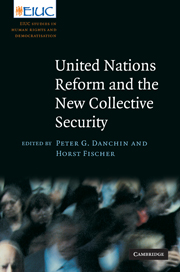Book contents
- Frontmatter
- Contents
- List of contributors
- Series editors' preface
- Preface
- List of abbreviations
- Introduction: the new collective security
- PART I Law and politics in United Nations reform
- PART II Defining “threats” to collective security
- PART III Prevention and responses
- PART IV Perspectives on the ground
- 12 Developing security in the eastern Democratic Republic of the Congo: MONUC as a practical example of (failing) collective security
- 13 Indirect power: a critical look at civil society in the new Human Rights Council
- 14 Collective security: a village-eye view
- Bibliography
- Index
14 - Collective security: a village-eye view
from PART IV - Perspectives on the ground
Published online by Cambridge University Press: 05 May 2010
- Frontmatter
- Contents
- List of contributors
- Series editors' preface
- Preface
- List of abbreviations
- Introduction: the new collective security
- PART I Law and politics in United Nations reform
- PART II Defining “threats” to collective security
- PART III Prevention and responses
- PART IV Perspectives on the ground
- 12 Developing security in the eastern Democratic Republic of the Congo: MONUC as a practical example of (failing) collective security
- 13 Indirect power: a critical look at civil society in the new Human Rights Council
- 14 Collective security: a village-eye view
- Bibliography
- Index
Summary
I have named this present report “In Larger Freedom” to stress the enduring relevance of the Charter of the UN and to emphasize that its purposes must be advanced in the lives of individual men and women. The notion of larger freedom also encapsulates the idea that development, security and human rights go hand in hand.
Kofi Annan, 2005In his 1945 film Distant Thunder, Satyajit Ray portrayed the interconnected nature of global affairs and the rhythm of daily life in a village in India. The film describes how the high prices being paid in Europe for rice and other staples during the Second World War brought starvation and death to the Indian village. Upon viewing the film in 2007, one cannot help but wonder how much greater the impact would be today, given the massive processes of globalization that have taken place since 1945. Considering the impact of globalization's complex set of interacting economic and political forces on ordinary people, no discussion of collective security can be complete without examining its relevance to these “villagers,” a population composed of the world's millions of impoverished rural and urban men and women who have little influence on the power structures and other factors that govern their daily lives.
One region of such villages is Negros Occidental in the Philippines, a province where one of the authors of this chapter belongs to the non-governmental organizations (NGOs) Broad Initiatives for Negros Development (BIND), Human Rights Defenders Negros, and the coalition Mediators for Peace.
- Type
- Chapter
- Information
- United Nations Reform and the New Collective Security , pp. 365 - 393Publisher: Cambridge University PressPrint publication year: 2010



